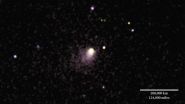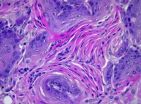(Press-News.org) Einstein's theory of relativity envisions time as a spatial dimension, like height, width, and depth. But unlike those other dimensions, time seems to permit motion in only one direction: forward. This directional asymmetry — the "arrow of time" — is something of a conundrum for theoretical physics.
But is it something we can see?
An international group of computer scientists believes that the answer is yes. At the IEEE Conference on Computer Vision and Pattern Recognition this month, they'll present a new algorithm that can, with roughly 80 percent accuracy, determine whether a given snippet of video is playing backward or forward.
"If you see that a clock in a movie is going backward, that requires a high-level understanding of how clocks normally move," says William Freeman, a professor of computer science and engineering at MIT and one of the paper's authors. "But we were interested in whether we could tell the direction of time from low-level cues, just watching the way the world behaves."
By identifying subtle but intrinsic characteristics of visual experience, the research could lead to more realistic graphics in gaming and film. But Freeman says that that wasn't the researchers' primary motivation.
"It's kind of like learning what the structure of the visual world is," he says. "To study shape perception, you might invert a photograph to make everything that's black white, and white black, and then check what you can still see and what you can't. Here we're doing a similar thing, by reversing time, then seeing what it takes to detect that change. We're trying to understand the nature of the temporal signal."
Word perfect
Freeman and his collaborators — his students Donglai Wei and YiChang Shih; Lyndsey Pickup and Andrew Zisserman from Oxford University; Changshui Zhang and Zheng Pan of Tsinghua University; and Bernhard Schölkopf of the Max Planck Institute for Intelligent Systems in Tübingen, Germany — designed candidate algorithms that approached the problem in three different ways. All three algorithms were trained on a set of short videos that had been identified in advance as running either forward or backward.
The algorithm that performed best begins by dividing a frame of video into a grid of hundreds of thousands of squares; then it divides each of those squares into a smaller, four-by-four grid. For each square in the smaller grid, it determines the direction and distance that clusters of pixels move from one frame to the next.
The algorithm then generates a "dictionary" of roughly 4,000 four-by-four grids, where each square in a grid represents particular directions and degrees of motion. The 4,000-odd "words" in the dictionary are chosen to offer a good approximation of all the grids in the training data. Finally, the algorithm combs through the labeled examples to determine whether particular combinations of "words" tend to indicate forward or backward motion.
Following standard practice in the field, the researchers divided their training data into three sets, sequentially training the algorithm on two of the sets and testing its performance against the third. The algorithm's success rates were 74 percent, 77 percent, and 90 percent.
One vital aspect of the algorithm is that it can identify the specific regions of a frame that it is using to make its judgments. Examining the words that characterize those regions could reveal the types of visual cues that the algorithm is using — and perhaps the types of cues that the human visual system uses as well.
The next-best-performing algorithm was about 70 percent accurate. It was based on the assumption that, in forward-moving video, motion tends to propagate outward rather than contracting inward. In video of a break in pool, for instance, the cue ball is, initially, the only moving object. After it strikes the racked balls, motion begins to appear in a wider and wider radius from the point of contact.
Probable cause
The third algorithm was the least accurate, but it may be the most philosophically interesting. It attempts to offer a statistical definition of the direction of causation.
"There's a research area on causality," Freeman says. "And that's actually really quite important, medically even, because in epidemiology, you can't afford to run the experiment twice, to have people experience this problem and see if they get it and have people do that and see if they don't. But you see things that happen together and you want to figure out: 'Did one cause the other?' There's this whole area of study within statistics on, 'How can you figure out when something did cause something else?' And that relates in an indirect way to this study as well."
Suppose that, in a video, a ball is rolling down a ramp and strikes a bump that briefly launches it into the air. When the video is playing in the forward direction, the sudden change in the ball's trajectory coincides with a visual artifact: the bump. When it's playing in reverse, the ball suddenly leaps for no reason. The researchers were able to model that intuitive distinction as a statistical relationship between a mathematical model of an object's motion and the "noise," or error, in the visual signal.
Unfortunately, the approach works only if the object's motion can be described by a linear equation, and that's rarely the case with motions involving human agency. The algorithm can determine, however, whether the video it's being applied to meets that criterion. And in those cases, its performance is much better.
INFORMATION:
Written by Larry Hardesty, MIT News Office
Can we see the arrow of time?
Algorithm can determine, with 80 percent accuracy, whether video is running forward or backward
2014-06-19
ELSE PRESS RELEASES FROM THIS DATE:
New driver of atherosclerosis offers potential as therapeutic target
2014-06-19
DALLAS – June 19, 2014 – A new driver of atherosclerosis has been identified by researchers at UT Southwestern Medical Center. This molecule, known as 27HC (27-hydroxycholesterol), has been found to exacerbate the development of the condition, and may prove to be a promising therapeutic target.
Atherosclerosis is characterized by the build-up of lesions (or plaques) formed from lipids, such as cholesterol and fatty acids. Ruptured plaques can partially or completely block blood flow, potentially leading to a heart attack or stroke. A member of a larger family of molecules ...
NASA's swift satellite tallies water production of Mars-bound comet
2014-06-19
In late May, NASA's Swift satellite imaged comet Siding Spring, which will brush astonishingly close to Mars later this year. These optical and ultraviolet observations are the first to reveal how rapidly the comet is producing water and allow astronomers to better estimate its size.
"Comet Siding Spring is making its first passage through the inner solar system and is experiencing its first strong heating from the sun," said lead researcher Dennis Bodewits, an astronomer at the University of Maryland College Park (UMCP). "These observations are part of a two-year-long ...
NASA's Hubble finds dwarf galaxies formed more than their fair share of universe's stars
2014-06-19
They may be little, but they pack a big star-forming punch. New observations from NASA's Hubble Space Telescope show small galaxies, also known as dwarf galaxies, are responsible for forming a large proportion of the universe's stars.
Studying this early epoch of the universe's history is critical to fully understanding how these stars formed and how galaxies grew and evolved 3.5 to 6 billion years after the beginning of the universe. The result supports a decade-long investigation into whether there is a link between a galaxy's mass and its star-forming activity, and ...
Georgia Tech research identifies Android security weaknesses caused by performance design
2014-06-19
Georgia Tech researchers have identified a weakness in one of Android's security features and will present their work at Black Hat USA 2014, which will be held August 6-7 in Las Vegas.
The research, titled Abusing Performance Optimization Weaknesses to Bypass ASLR, identifies an Android performance feature that weakens a software protection called Address Space Layout Randomization (ASLR), leaving software components vulnerable to attacks that bypass the protection. The work is aimed at helping security practitioners identify and understand the future direction of such ...
NASA and NAU researchers welcome unexpected asteroid findings
2014-06-19
What seemed to be rock-solid assumptions about the nature of small asteroids may end in collections of rubble or even a cloud of dust, but in such findings lies the lure of the unexpected.
Northern Arizona University researchers David Trilling and Michael Mommert, while playing a well-defined role in the NASA Asteroid Initiative, are beginning to wonder if they have found a separate path of investigation.
The two researchers presented their findings about asteroid 2011 MD on Thursday during a NASA event updating progress on the path to capturing a small asteroid and ...
A new tool to confront lung cancer
2014-06-19
Only 15% of patients with squamous cell lung cancer – the second most common lung cancer – survive five years past diagnosis. Little is understood about how the deadly disease arises, preventing development of targeted therapies that could serve as a second line of defense once standard chemotherapy regimens fail.
Published online in Cell Reports on June 19, Huntsman Cancer Institute investigators report that misregulation of two genes, sox2 and lkb1, drives squamous cell lung cancer in mice. The discovery uncovers new treatment strategies, and provides a clinically relevant ...
A better imager for identifying tumors
2014-06-19
WASHINGTON, June 19, 2014—Before they excise a tumor, surgeons need to determine exactly where the cancerous cells lie. Now, research published today in The Optical Society's (OSA) journal Optics Letters details a new technique that could give surgeons cheaper and more lightweight tools, such as goggles or hand-held devices, to identify tumors in real time in the operating room.
The new technology, developed by a team at the University of Arizona and Washington University in St. Louis, is a dual-mode imager that combines two systems—near-infrared fluorescent imaging to ...
Swiftly moving gas streamer eclipses supermassive black hole
2014-06-19
Astronomers have discovered strange and unexpected behaviour around the supermassive black hole at the heart of the galaxy NGC 5548. The international team of researchers detected a clumpy gas stream flowing quickly outwards and blocking 90 percent of the X-rays emitted by the black hole. This activity could provide insights into how supermassive black holes interact with their host galaxies.
The discovery of the unusual behaviour in NGC 5548 is the result of an intensive observing campaign using major ESA and NASA space observatories, including the NASA/ESA Hubble Space ...
LLNL, MIT researchers develop new ultralight, ultrastiff 3D printed materials
2014-06-19
LIVERMORE, Calif. – Imagine a material with the same weight and density as aerogel -- a material so light it's called 'frozen smoke' -- but with 10,000 times more stiffness. This material could have a profound impact on the aerospace and automotive industries as well as other applications where lightweight, high-stiffness and high-strength materials are needed.
Lawrence Livermore and Massachusetts Institute of Technology (MIT) researchers have developed a material with these properties using additive micro-manufacturing processes. The research team's findings are published ...
Kids with strong bonds to parents make better friends, can adapt in relationships
2014-06-19
URBANA, Ill. – What social skills does a three-year-old bring to interactions with a new peer partner? If he has strong bonds to his parents, the child is likely to be a positive, responsive playmate, and he'll be able to adapt to a difficult peer by asserting his needs, according to a new University of Illinois study published in Developmental Psychology.
"Securely attached children are more responsive to suggestions or requests made by a new peer partner. A child who has experienced a secure attachment relationship with caregivers is likely to come into a new peer relationship ...
LAST 30 PRESS RELEASES:
UT Health San Antonio awarded $3 million in CPRIT grants to bolster cancer research and prevention efforts in South Texas
Third symposium spotlights global challenge of new contaminants in China’s fight against pollution
From straw to soil harmony: International team reveals how biochar supercharges carbon-smart farming
Myeloma: How AI is redrawing the map of cancer care
Manhattan E. Charurat, Ph.D., MHS invested as the Homer and Martha Gudelsky Distinguished Professor in Medicine at the University of Maryland School of Medicine
Insilico Medicine’s Pharma.AI Q4 Winter Launch Recap: Revolutionizing drug discovery with cutting-edge AI innovations, accelerating the path to pharmaceutical superintelligence
Nanoplastics have diet-dependent impacts on digestive system health
Brain neuron death occurs throughout life and increases with age, a natural human protein drug may halt neuron death in Alzheimer’s disease
SPIE and CLP announce the recipients of the 2025 Advanced Photonics Young Innovator Award
Lessons from the Caldor Fire’s Christmas Valley ‘Miracle’
Ant societies rose by trading individual protection for collective power
Research reveals how ancient viral DNA shapes early embryonic development
A molecular gatekeeper that controls protein synthesis
New ‘cloaking device’ concept to shield sensitive tech from magnetic fields
Researchers show impact of mountain building and climate change on alpine biodiversity
Study models the transition from Neanderthals to modern humans in Europe
University of Phoenix College of Doctoral Studies releases white paper on AI-driven skilling to reduce burnout and restore worker autonomy
AIs fail at the game of visual “telephone”
The levers for a sustainable food system
Potential changes in US homelessness by ending federal support for housing first programs
Vulnerability of large language models to prompt injection when providing medical advice
Researchers develop new system for high-energy-density, long-life, multi-electron transfer bromine-based flow batteries
Ending federal support for housing first programs could increase U.S. homelessness by 5% in one year, new JAMA study finds
New research uncovers molecular ‘safety switch’ shielding cancers from immune attack
Bacteria resisting viral infection can still sink carbon to ocean floor
Younger biological age may increase depression risk in older women during COVID-19
Bharat Innovates 2026 National Basecamp Showcases India’s Most Promising Deep-Tech Ventures
Here’s what determines whether your income level rises or falls
SCIE indexation achievement: Celebrate with Space: Science & Technology
Children’s Hospital Colorado performs region’s first pediatric heart and liver dual organ transplant
[Press-News.org] Can we see the arrow of time?Algorithm can determine, with 80 percent accuracy, whether video is running forward or backward






